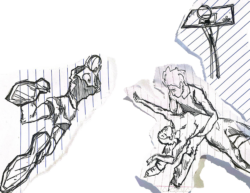After years of being decried as a sideshow at best and an inhumane blood sport at worst, mixed martial arts have seemingly reached the mainstream, garnering national media coverage with the commercial success of Ultimate Fighting Championship. But at Georgetown, the sport remains underground, where a small cadre of competitive mixed martial artists thrives without any kind of sanction by the University.
There likely have always been amateur wrestlers and fighters like Christopher Mika (COL ’12) among the thousands of students on the Hilltop, but their organized training and competition began only recently. As a freshman in the fall of 2008, Mika started what is now called Hoya MMA after a chance encounter in Yates.
“We all wear similar fight shorts and I’d wear them to the gym,” Mika said. “So I showed up at Yates with my shorts on and I saw Payton [Kilcarr, another Hoya MMA competitor] … and I was like, ‘Hey, do you do mixed martial arts?’”
Kilcarr (COL ’11) did, and he knew a few more people who practiced the sport as well. Adding a few more fighters they met at the gym, Hoya MMA soon had seven members who would spar and grapple on spare mats in Yates. Their sessions would not last long, however, before the gym’s staff kicked them out, probably because they feared the liability issues that might accompany essentially unsupervised combat.
“They threw [the mats] out one day, because they were tired of us coming in there,” Jan Gaetjens (COL ’12) said.
Gaetjens and Mika serve as the de facto captains of Hoya MMA. They manage the Facebook page for the group and spearheaded an effort to obtain Student Activities Committee funding last fall. The fighters had hoped to take their organization to the next level, perhaps getting some money for an instructor or equipment, or at least getting a sanctioned training space. But their request was ultimately denied by SAC, which cited a lack of available space.
They were frustrated, but the members of Hoya MMA were not deterred. They continued to train and fight on their own, with plenty of success.
“We don’t have money to go hire a coach and teach us,” Mika said. “We have a total of about 8 to 10 very, very experienced guys. We have black belts in Japanese jiu jitsu, in kung fu, in taekwondo. We bring all those skill sets together and teach each other.”
The fighters show off their combined body of knowledge at events around the area, ranging from North American Grappling Association-sanctioned submission grappling tournaments to amateur UFC-style cage fights.
Competing against fighters from local gyms as well as area colleges, the men of Hoya MMA more than hold their own. Three of them placed at the most recent D.C. NAGA tournament, including Kilcarr, who took home silver in the featherweight division.
“Even though we don’t necessarily have school backing yet, we bring that Georgetown pride. We’re sort of representing it as a team,” Gaetjens said. “It’s great to go out there and have that level of competition, where everyone is cheering you on.”
Now the experienced fighters are looking to share the thrill of mixed martial arts. Hoya MMA didn’t let SAC’s rejection keep them from bringing their own table to this month’s SAC Fair. The group drew in dozens of curious recruits, no doubt attracted by the demonstrations Mika and Gaetjens performed on Copley Lawn.
“We were amazed at how many people signed up, and we were especially amazed at how many people came to the first practice,” Mika said. “About 50 totally new people. Some people with just as much experience as some of our best competitors, and most people with absolutely none at all.”
That puts Mika and his fellow fighters in a new position, instructing untrained students instead of sharing techniques with peers. It is not a completely foreign situation for some of the veterans, however, many of whom have experience working with the instructors back at their home gyms.
Still, just as the question of liability kept them out of Yates, the members of Hoya MMA must be concerned with the potential for injuries and other physical problems. Mika downplayed the issue, citing the fact that in their years of training together, none of the fighters had suffered an injury.
The newcomers aren’t too concerned either.
“These guys are great,” Blair Vorsatz (COL ’14), one of the new recruits, said. “They spend a lot of time with us going over stuff even though they have to train. It’s a wonderful environment.”
All the fresh faces joining Hoya MMA have renewed the founders’ interest in bringing their organization out from the underground. Discouraged by SAC’s decision last fall, they had essentially accepted that Hoya MMA would have to fend for itself. But with so much new interest in mixed martial arts, they will wage another fight for SAC funding this semester.
“With all this support from new people coming and joining, it’s really resuscitated our desire and drive to make this an official and long-lasting institution at Georgetown,” Mika said.
The funding board will learn that it’s not so easy to get a mixed martial artist to submit.




